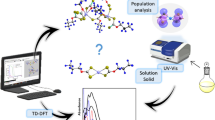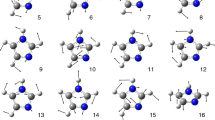Abstract
The CD spectrum of the complexesQ·2CuCl2,Q·2CoCl2,Q·2NiCl2·8H2O,Q·3CrCl3·6H2O,Q·PdCl2·3H2O andQ·2PdCl2·5H2O (whereQ=quinine) inDMF orDMSO solution revealsCotton effects in the d-d absorption range. TheCotton effects are relatively strong in the case of Cu(II) and Pd(II) complexes which implies that only in these complexes the hydroxyl group of the quinine molecule possibly participates in the coordination with these metal ions by formation of a chelate ring. The IR spectra of the complexes of Pd(II) are discussed in this respect.
Zusammenfassung
Die CD-Spektren der KomplexeQ·2CuCl2,Q·2CoCl2,Q·2NiCl2·8H2O,Q·3CrCl3·6H2O,Q·PdCl2·3H2O undQ·2PdCl2·5H2O, (Q=Chinin), inDMF-bzw.DMSO-Lösungen zeigenCotton-Effekte im Gebiet der d-d-Elektronenübergänge. DieCotton-Effekte sind relativ stark im Falle der Cu(II)- und Pd(II)-Komplexe, was zu der Annahme führt, daß die Hydroxygruppe des Chininmoleküls in diesen Komplexen wahrscheinlich an der Koordination dieser Metallionen durch Chelatringbildung teilnimmt. Unter diesem Aspekt werden die IR-Spektren der Pd(II)-Komplexe untersucht.
Similar content being viewed by others
References
Tsangaris J. M., Baxevanides G. Th., Z. Naturforsch.29b, 532 (1974).
Larsen E., Olsen I., Acta Chem. Scand.18, 1025 (1964).
Fujita J., Yasui T., Shimura Y., Bull. Chem. Soc. Japan38, 654 (1965);Yasui T., Hidaka J., Shimura Y., ibid.39, 2147 (1966).
Hawkins C. J., Lawson P. J., Inorg. Chem.9, 6 (1970).
Hawkins C. J., Lawrance G. A., Inorg. Nucl. Chem. Lett.9, 483 (1973).
Cragel J., Douglas B. D., J. Coord. Chem.5, 61 (1976).
Cjarnecki J. J., Margerum D. W., Inorg. Chem.16, 1997 (1977).
Kerek F., Snatzke G., Ponsold K., Schönecker B., Tetrahedron33, 2013 (1977).
Geary W. J., Coord. Chem. Rev.7, 109 (1971).
van Leeuwen P. W. N. M., Rec. trav. Chim. Pays-Bas86, 252 (1967).
Coulden J. D. S., Spectrochimica Acta16, 715 (1960).
Larson R., Acta Chem. Scand.19, 787 (1965).
Author information
Authors and Affiliations
Rights and permissions
About this article
Cite this article
Tsangaris, J.M., Kabanos, T.A. Circular dichroism of the complexes of quinine with copper(II), nickel(II), cobalt(II), chromium(III) and palladium(II) chlorides. Monatsh Chem 113, 1393–1398 (1982). https://doi.org/10.1007/BF00808938
Received:
Accepted:
Issue Date:
DOI: https://doi.org/10.1007/BF00808938




